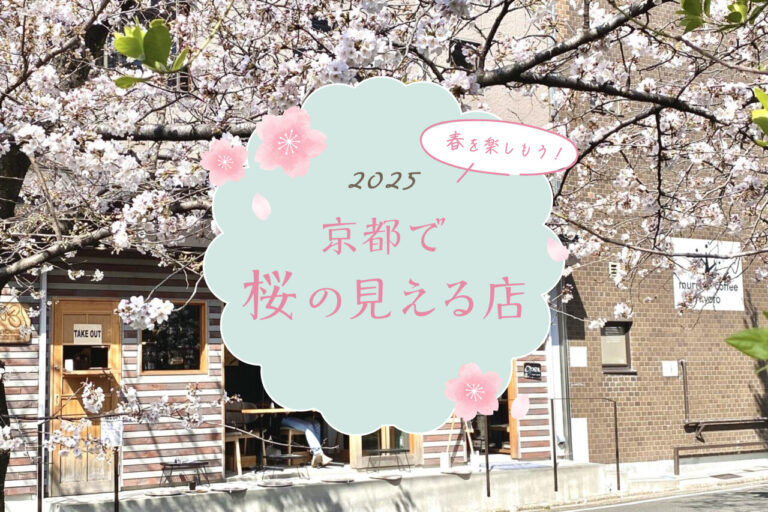
[Let's enjoy the spring! Kyoto's cherry blossom viewing...
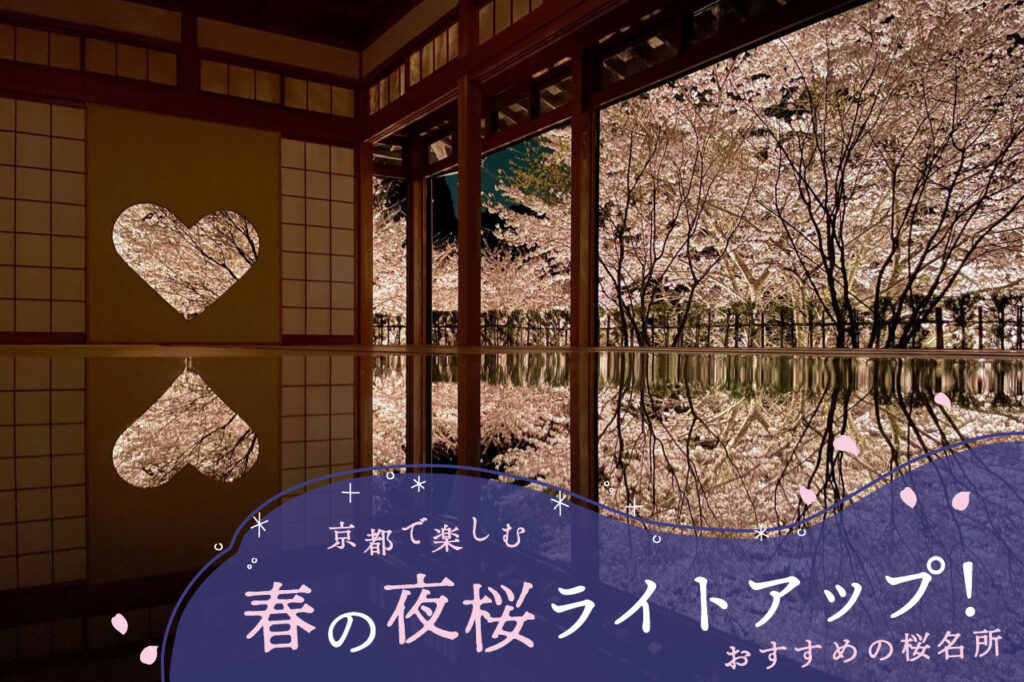

The cherry blossom season has come again this year. Depending on where and when you view them, the cherry blossoms will show you different expressions. In this issue, we will introduce information on cherry blossom illumination in Kyoto, from famous temples where you can enjoy nighttime viewing only, to hidden places where you can stroll freely. Enjoy the fantastic nighttime cherry blossoms, which are different from those in the daytime.
Kiyomizu Temple is one of the representative temples of Kyoto.
During the special nighttime viewing in spring, spots on the temple grounds, such as the cherry blossoms at night and the 31-meter-high three-story pagoda, are lit up, offering visitors an ethereal view of the city. Visitors can also enjoy the night view of Kyoto from the Kiyomizu-no-butai (stage of Kiyomizu) along with the nighttime cherry blossoms.
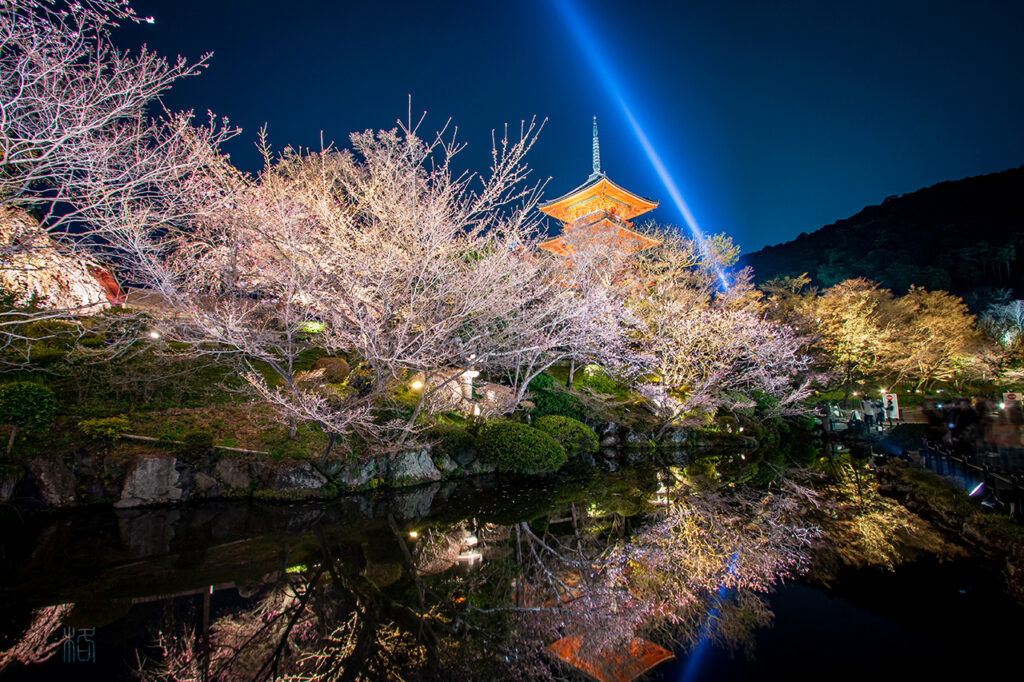
Photo courtesy of Kiyomizu Temple


Photo courtesy of Kiyomizu Temple

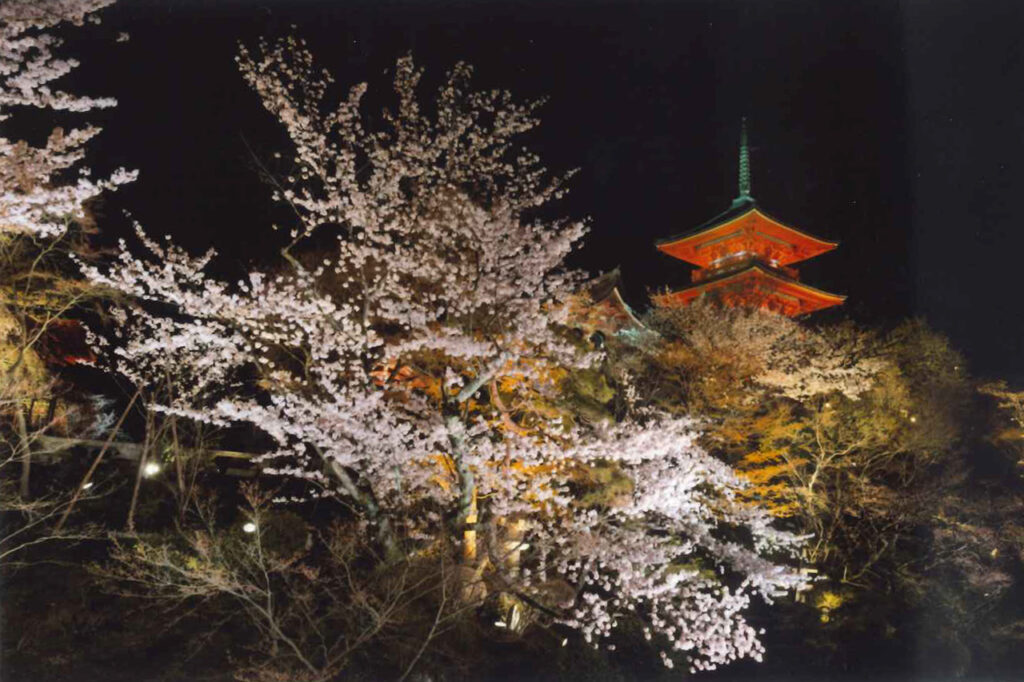
Photo courtesy of Kiyomizu Temple

Best time to see: late March to early April
Period / Tuesday, March 25, 2025 - Thursday, April 3, 2025
Hours of visitation: 18:00 - 21:00 (reception closes at 21:00)
Admission: 500 yen for adults, 200 yen for elementary and junior high school students
The largest vermilion Otorii (Grand Gate) in Kyoto towers over the shrine [Heian Jingu Shrine].
The "Heian Jingu Shrine Sakura Oto Yo (Night of Cherry Blossoms)" will be held again this year, with nighttime cherry blossoms and the sounds of artists adding color to the night in Kyoto. The red weeping cherry blossoms reflected on Seiho Pond in the South Garden, which writer Junichiro Tanizaki described as "clouds of crimson" in his novel "Hoso-Yuki," will be lit up. The Higashi Shinen Kihin Kan will be the stage for performances of Hichiriki, shamisen, koto, piano, and other instruments.
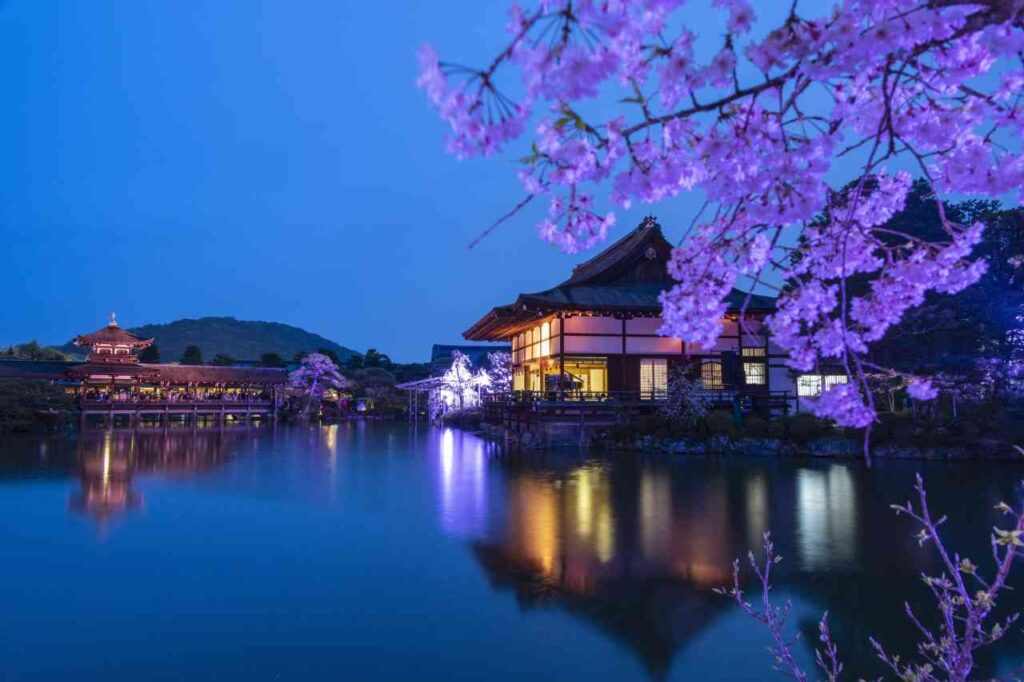

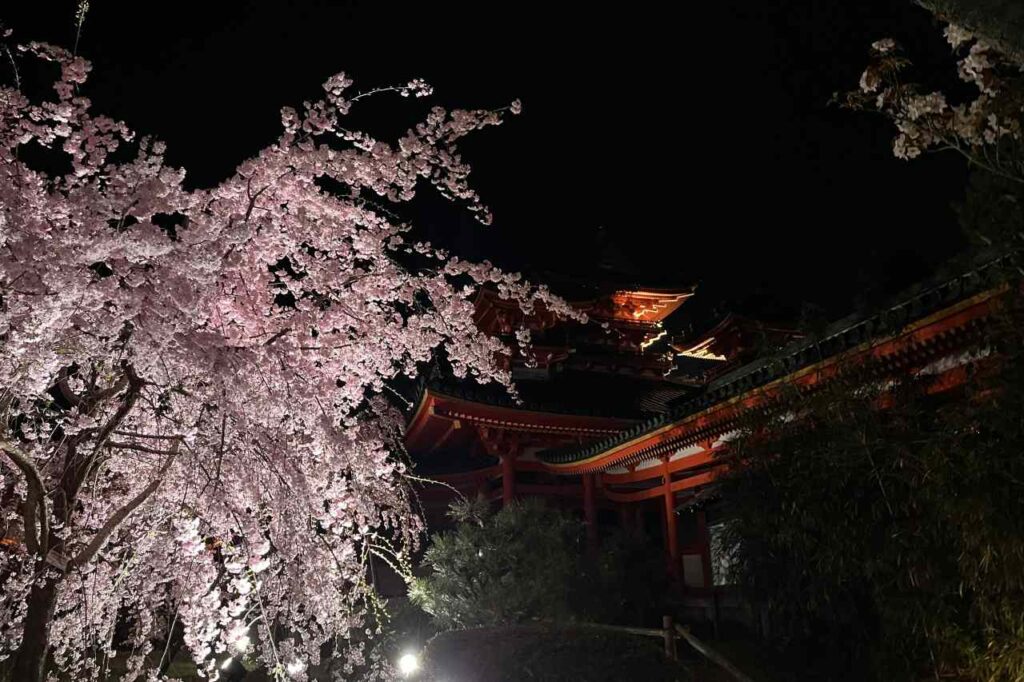

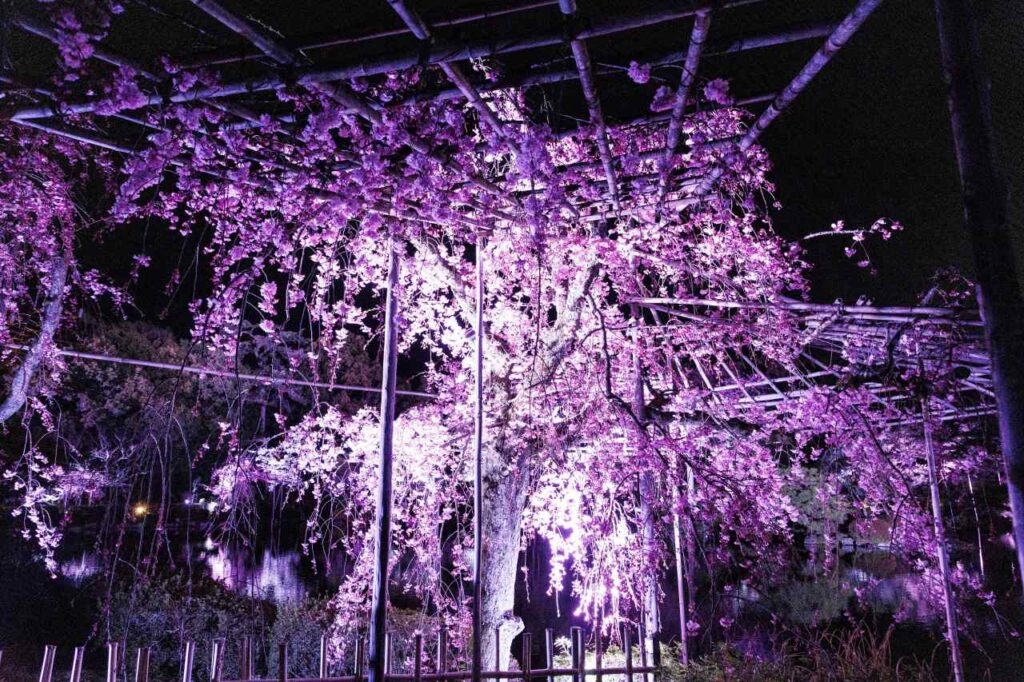

Best time to visit: Late March to mid-April
[Heian Jingu Shrine, Sakura Oto Yoru - Benishidare Concert 2025]
Period / April 2 (Wed) to 6 (Sun), 2025
Time/ 18:15 - 21:00, Part 1: 18:40 - 19:10 (Entrance reception/18:15 - 19:15), Part 2: 19:55 - 20:25 (Entrance reception/19:35 - 20:30)
*Parts 1 and 2 are completely interchangeable.
*No seats
※Detail isOfficial sitesee
Admission ticket with concert
Fee / 4,000 yen
Advance sale / 3,000 yen
Admission Ticket
Fee/2000 yen
Advance sale / 1,500 yen
All charged for elementary school students and older.
Inquiries: Tel. 075-241-6171 (Weekdays 10:00-17:00, "Heian Jingu Cherry Blossom Night" Office)
*Please refrain from contacting the Heian Jingu Shrine office.
No parking
Toji Temple was founded as a temple to protect the nation.
There are approximately 200 cherry trees, including Someiyoshino cherry trees, planted in the precincts of the shrine, and the "Fuji-zakura," a beautiful red weeping cherry tree said to be 130 years old, is famous. The "Fuji-zakura" is a must-see when illuminated against the backdrop of the five-story pagoda, a national treasure that symbolizes Kyoto.
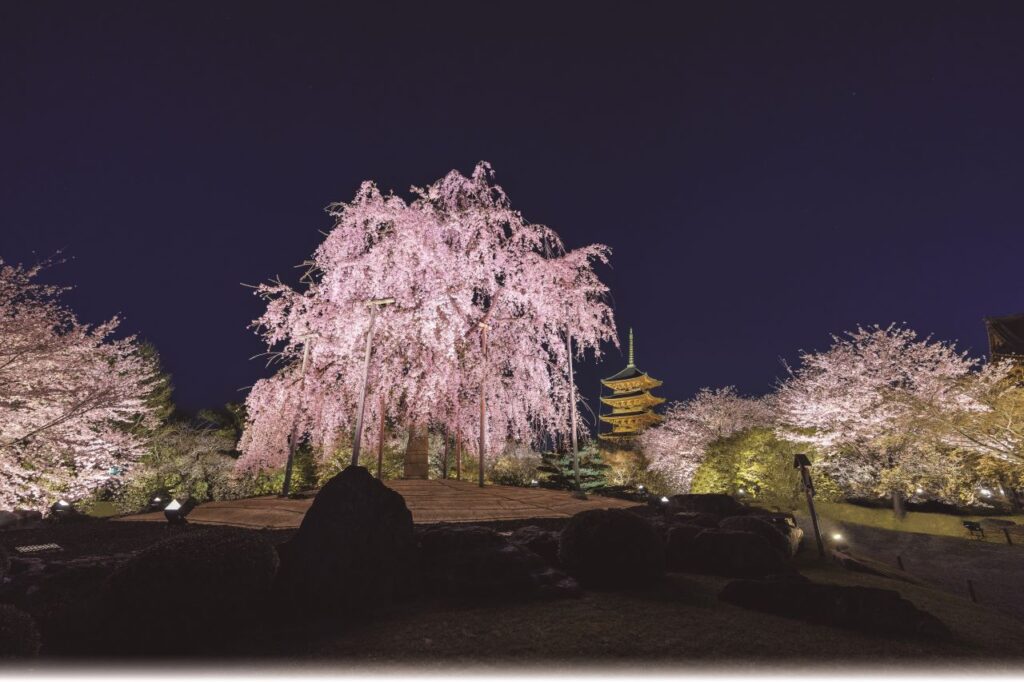

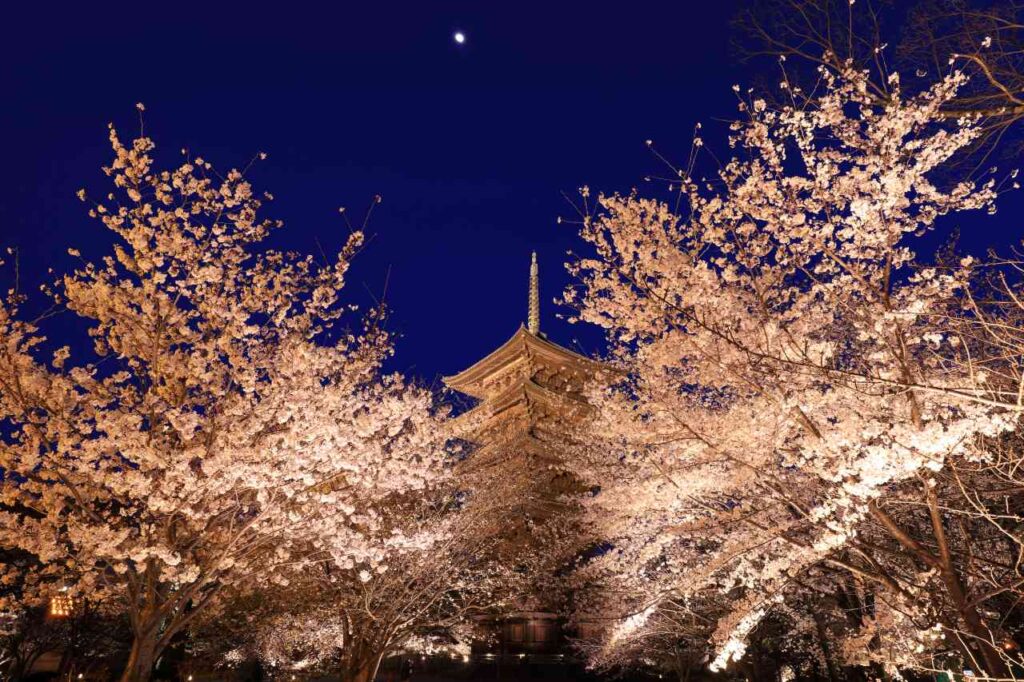

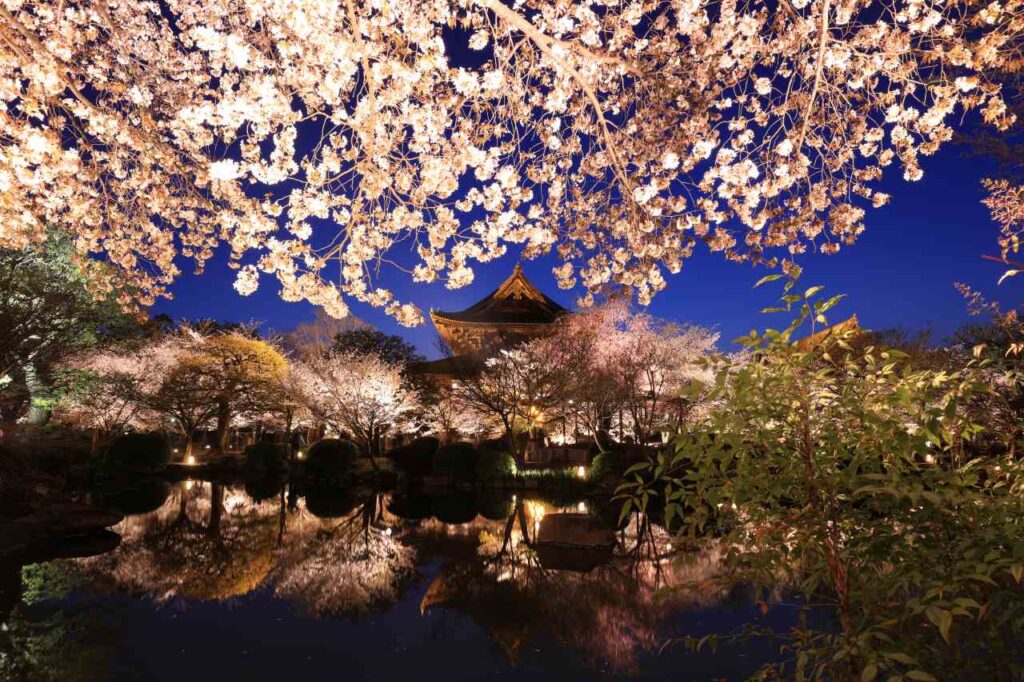

Best time to visit: Late March - early April
Toji Temple: Cherry blossoms illuminated at night (Kondo and Kodo halls: special nighttime viewing)
Period / March 15, 2025 (Sat) - April 13, 2025 (Sun)
Visiting hours: 18:00-21:30 (reception closes at 21:00)
Entrance fee: 1,000 yen for adults, 500 yen for junior high school students and younger
No group rates
Nijo Castle, a World Heritage Site, was built by Ieyasu Tokugawa and has been the setting for numerous historical events.
In spring, visitors can enjoy a wide variety of cherry blossoms, about 300 cherry trees of 50 varieties, including mountain cherry trees, village cherry trees, and double-red weeping cherry trees. During the festival, the cherry blossoms are lit up at night and projection mapping is performed in the historical space.
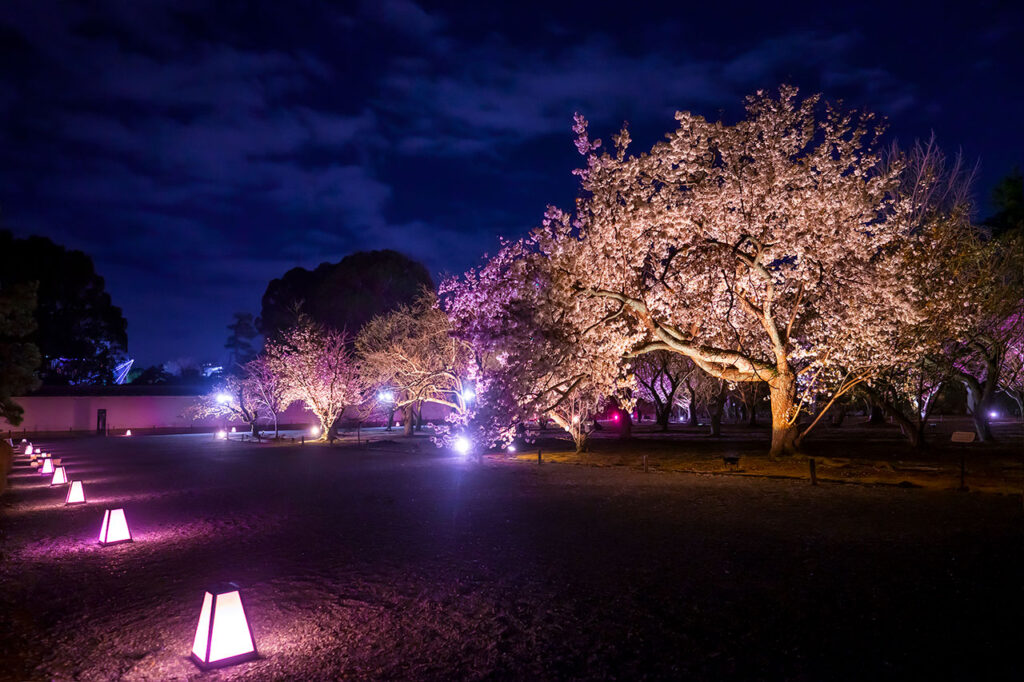

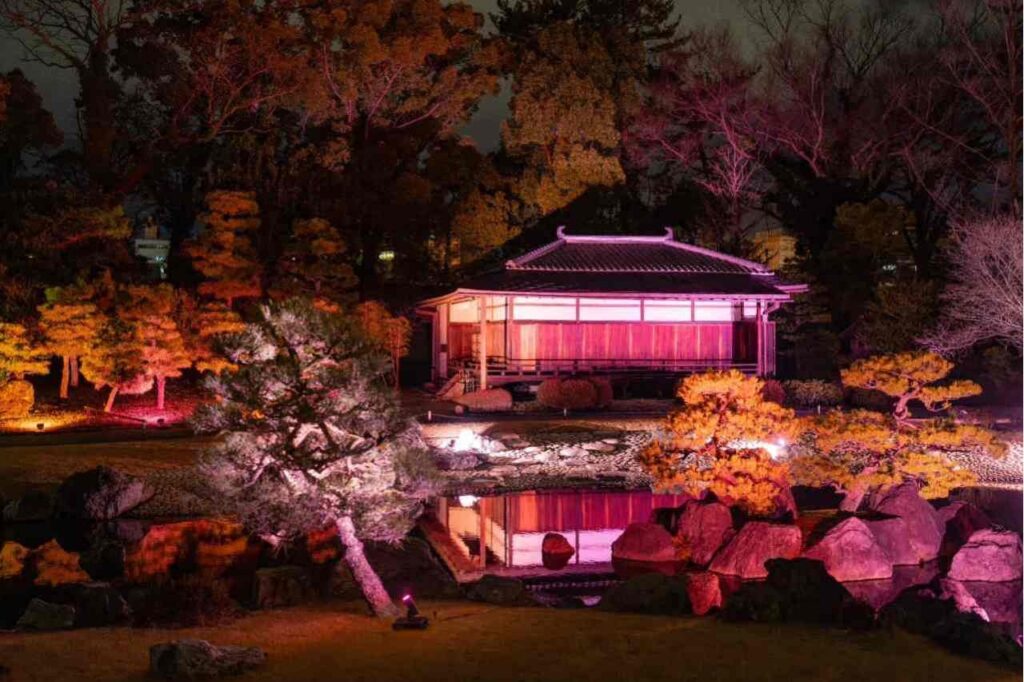

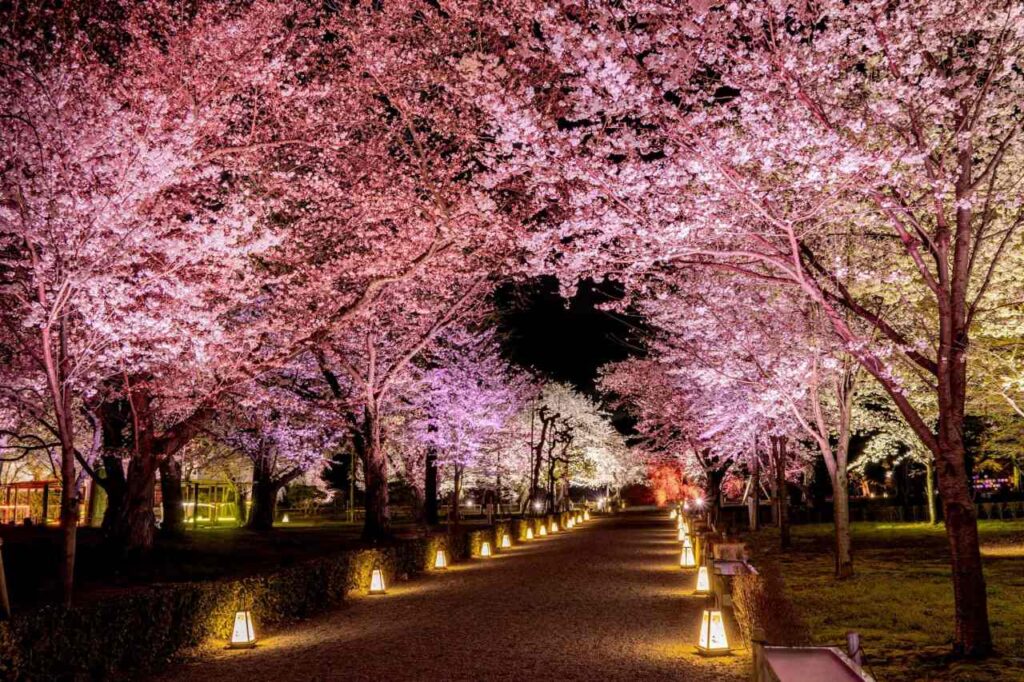

Best time to visit: Mid-March to mid-April
NAKED meets Nijo Castle 2025 Cherry Blossoms
Period / Friday, March 14, 2025 - Sunday, April 13, 2025
Hours/18:00-22:00 (last admission/21:00)
Admission/Junior high school students and older: 2,000 yen, elementary school students: 1,000 yen on Monday through Thursday.
Friday-Sunday and holidays: 2,500 yen for junior high school students and older, 1,500 yen for elementary school students
*Purchase specific date tickets for March 22 (Sat), March 29 (Sat), April 5 (Sat), and April 12 (Sat). No admission with other tickets.
Tickets for specific days are ¥2,800 for junior high school students and older, ¥1,800 for elementary school students.
【inquiry】
Tickets/0570-200-888(Kyodo Information 12:00-17:00 during the period *Closed on Saturdays, Sundays and national holidays)
Others/050-1750-3979 (NAKED meets Nijo Castle Management Office, weekdays during the period 17:00-22:00, Saturdays, Sundays and national holidays 12:00-22:00)
*Please do not contact the Nijo Castle Office directly.
https://event.naked.works/nijojo/spring//
The head temple of the Jodo sect [Chion-in].
Cherry blossom trees can be seen in a wide area from Higashiyama Hwacho-zan to Higashioji-dori. During the special nighttime viewing, the Yuzen-en Garden, with its magnificent weeping cherry blossoms, and other areas of the temple grounds are lit up. During the period, there will be Dharma talks, an event to experience "Namu Amidabutsu" by touching a wooden fish, and "Tsukikage Premium Tour," a 1.5-hour tour of the illuminated area with a monk.
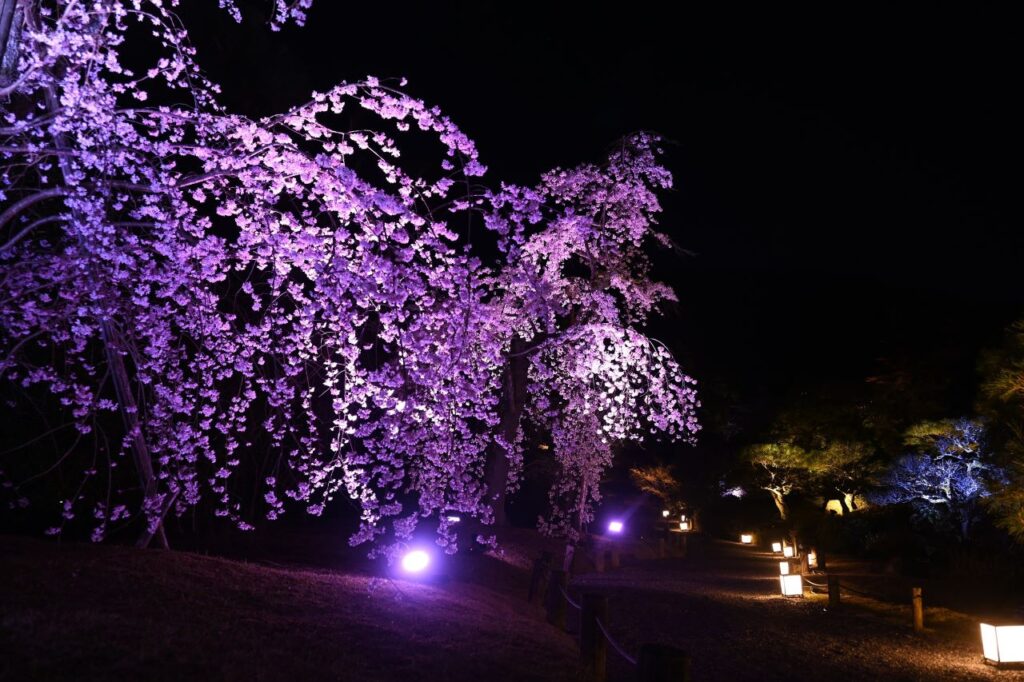

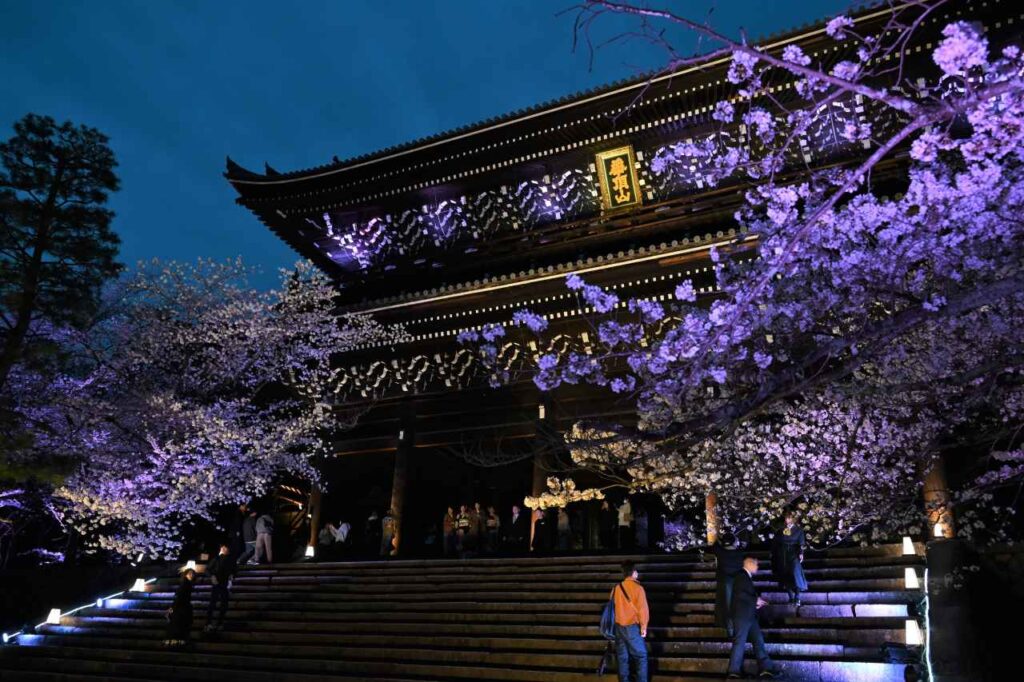

Best time to visit: Late March - early April
Chion-in Spring Light-up 2025
Period / Wednesday, March 26, 2025 - Sunday, April 6, 2025
Tsukikage Premium Tour" will be held on Thursdays, Saturdays, and Sundays during the period.
*Applications can be made byhere
Hours of visitation: 17:45 - 21:30 (reception closes at 21:00)
Admission fee: 800 yen for adults, 400 yen for elementary and junior high school students
Kodai-ji Temple was built by Nene Kodai-in, the wife of Hideyoshi Toyotomi, also known as Kita Masasho, as his final resting place and family grave.
The temple has been famous as a cherry blossom viewing spot since the late Edo period (1603-1868), including the "Kodaiji-zakura" mountain cherry blossoms by the Juukanmon gate leading to the Kaisandō Hall, and the weeping cherry blossoms in the Hojō are in magnificent bloom every year. The avenue of Someiyoshino cherry trees along "Nene-no-michi", the street in front of the temple gate, is also popular.
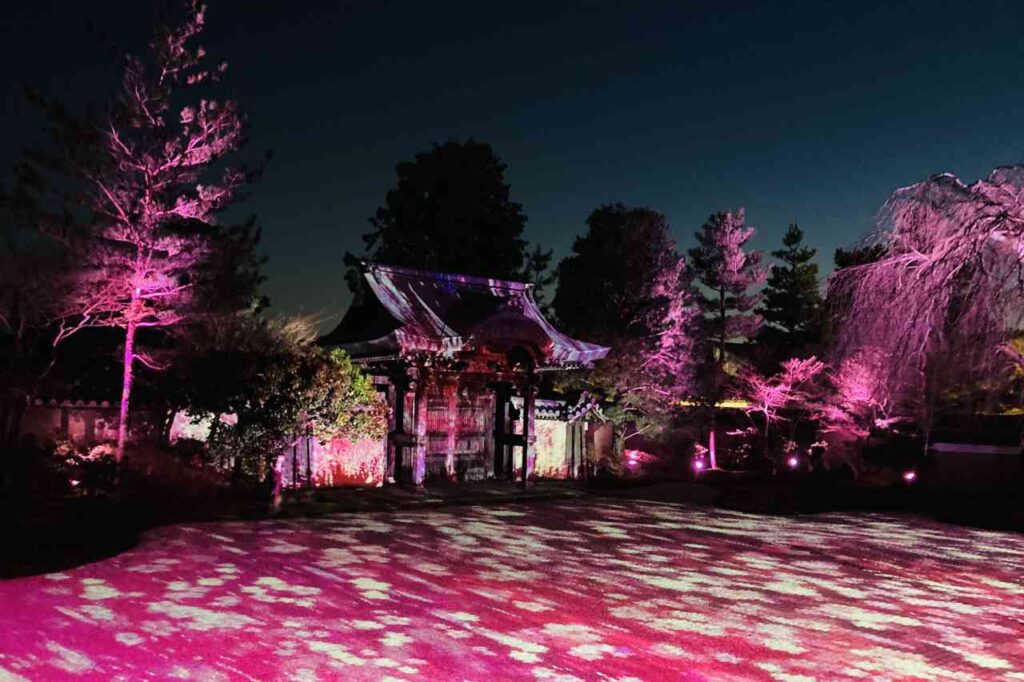

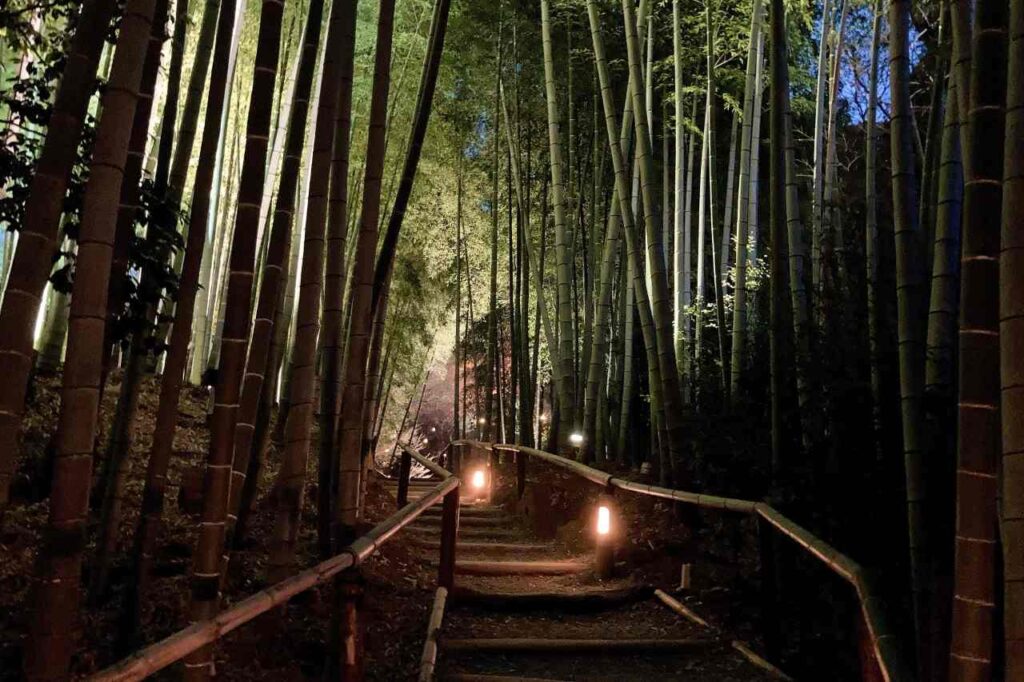
Illuminated bamboo grove

Best time to visit: Late March - early April
Spring Night Special Viewing "Prayer - Spring
Period / March 14, 2025 (Friday) - May 6, 2025 (Tuesday, national holiday)
Hours: 17:00-22:00 (last admission at 21:30)
Admission/ Adults 600 yen (with admission ticket to Palm Art Museum), Junior high and high school students 250 yen
Discounted tickets for 3 temples (Kodaiji Temple, Palm Art Museum, Entokuin Temple): 900 yen
Maruyama Park, the oldest park in Kyoto, opened in 1886.
With approximately 680 cherry trees, including weeping cherry trees, someiyoshino cherry trees, and mountain cherry trees, the park is known as one of the best cherry blossom viewing spots in Kyoto. In the center of the park is the famous weeping cherry tree, known as the "Gion no Yozakura" (Gion cherry tree at night), which is a sight to behold when lit up. During the festival, bonfires are lit from sundown, and many visitors can be seen at hanami teahouses and other hanami spots.


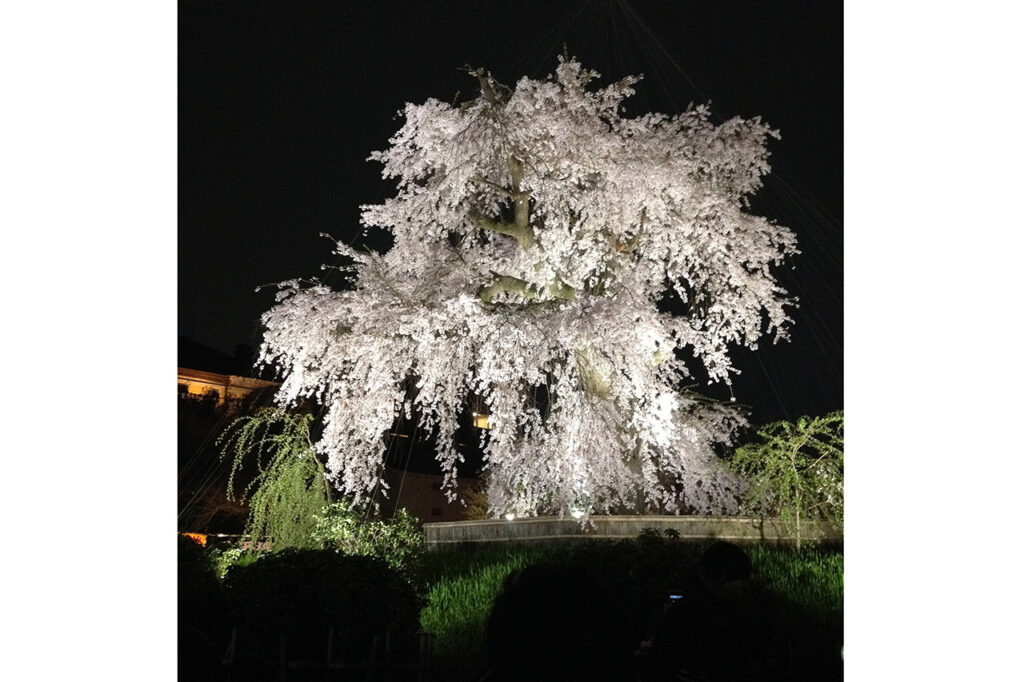

Best time to visit: Late March - early April
Illuminated weeping cherry trees in scenic Maruyama Park
Period / Tuesday, March 25, 2025 - Wednesday, April 9, 2025
*Bonfire is - Wednesday, April 2
Hours/18:00-22:00
free in the park
*Placement (spreading out blue sheets, etc. to reserve a place in advance) is prohibited.
Bonfire may be cancelled due to weather conditions such as strong wind warnings.
The Kyoto Botanical Garden is Japan's first public botanical garden and one of the largest in the Kansai region.
At night, approximately 300 cherry trees, including Someiyoshino and Yaebenishidare, will be illuminated, creating a dreamlike scene different from that of the daytime. During the nighttime, one of the largest greenhouses in Japan will be open free of charge, with approximately 4,500 varieties of tropical plants planted and exhibited.
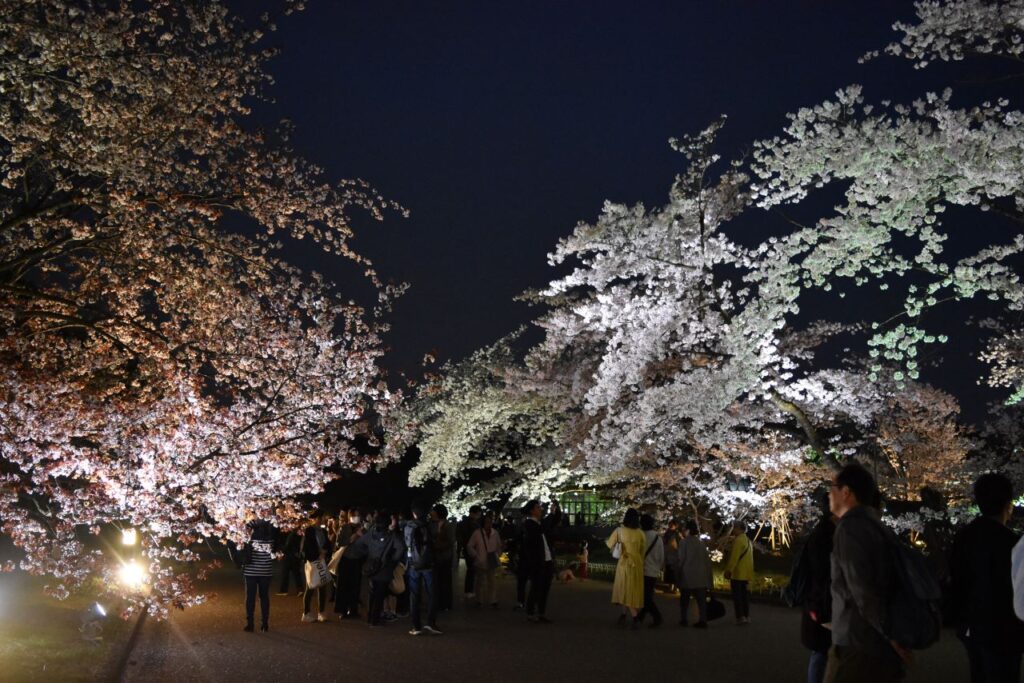

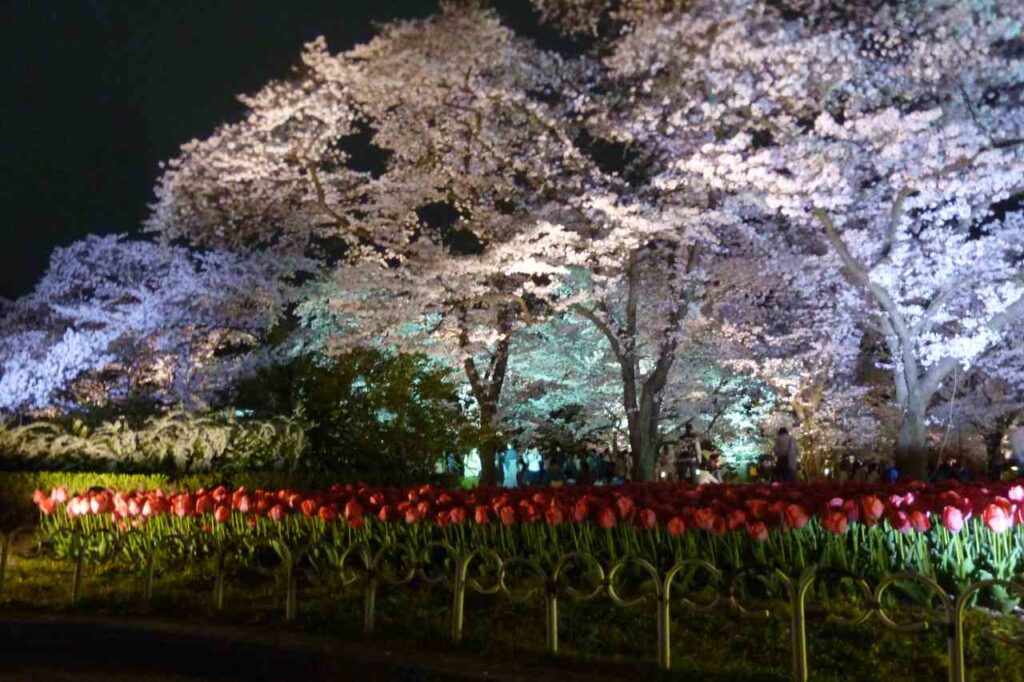

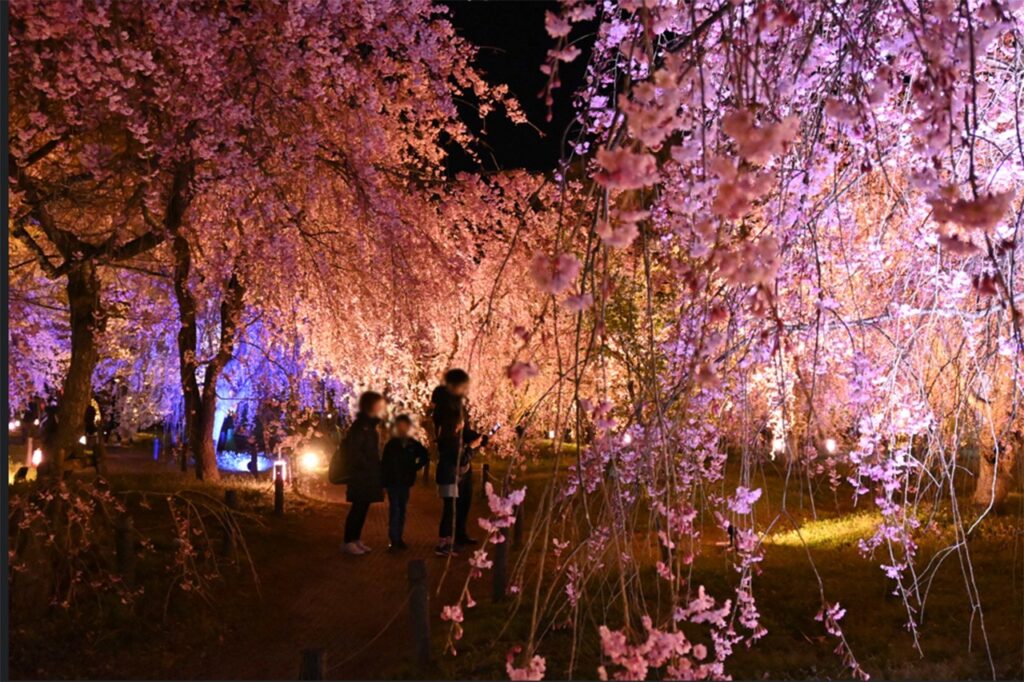

Best time to visit: Mid-March to early April
2025 Cherry Blossom Lights Up
Period / Tuesday, March 25, 2025 - Sunday, April 6, 2025
Admission Hours: 18:00 approx. after sunset - 21:00 (last admission at 20:00)
*No replacement for noon admission.
Admission: ¥200 for adults, ¥150 for high school students, free for junior high school students and younger
(From Tuesday, April 1, 2025, ¥500 for adults, ¥250 for high school students, and free for junior high school students and younger)
Hirano Shrine has been a popular cherry blossom viewing spot for the general public since the Edo period (1603-1867) as "Hirano no Yozakura" (Hirano night cherry blossoms).
The grounds are planted with 400 cherry trees of about 60 varieties, including many rare varieties that originated in this area. During the special nighttime illumination, visitors can enjoy the fantastic scenery of the cherry blossom garden and precincts illuminated by lights such as bonbori (paper lanterns) and lanterns.
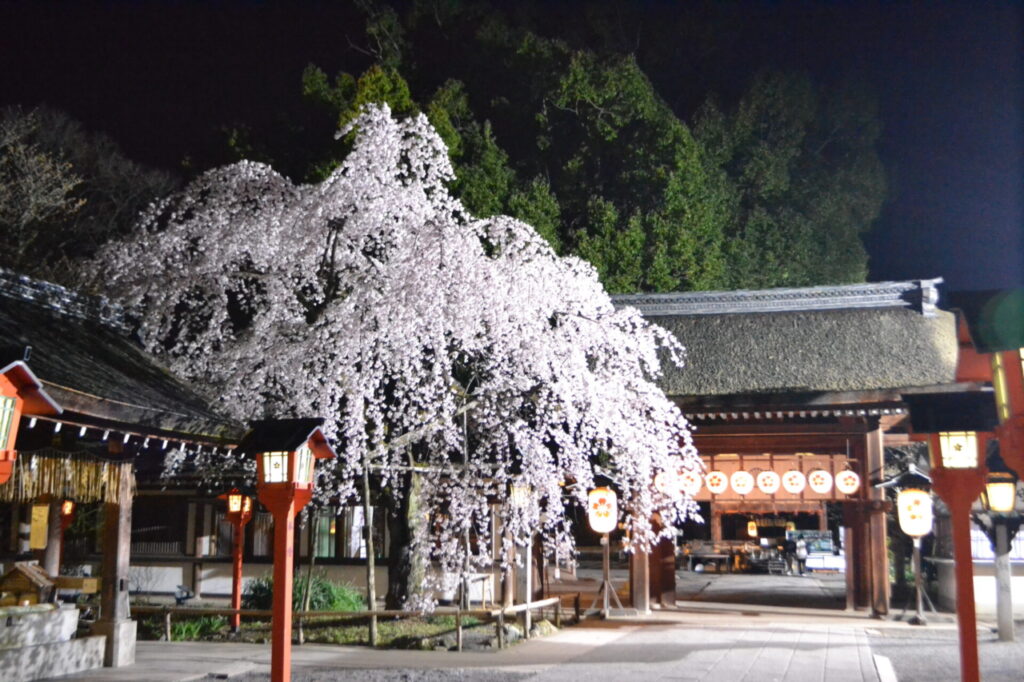

Best time to visit: Mid-March to mid-April
Hirano Shrine Nighttime Special Cherry Blossom Garden" (Japanese only)
Period / Saturday, March 22, 2025 - Sunday, April 13, 2025
Hours of visitation: Sunset - 21:00
Admission: Free (some sections require a fee)
Nagaoka Tenmangu Shrine is closely associated with Michizane Fujiwara.
Hachijo-ke Pond, with a circumference of 1 km, built by Prince Tomochu Hachijo in 1638, is illuminated. From the water bridge made of hinoki cypress, visitors can enjoy the dreamy view of cherry blossoms blooming in the night sky and their figures reflected in the pond.
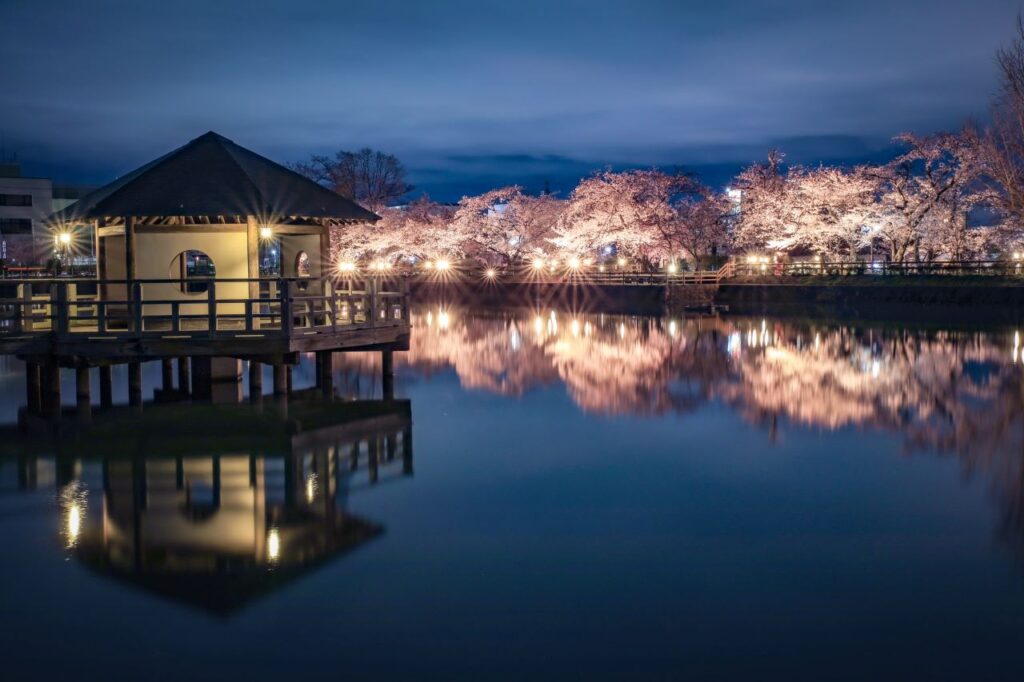

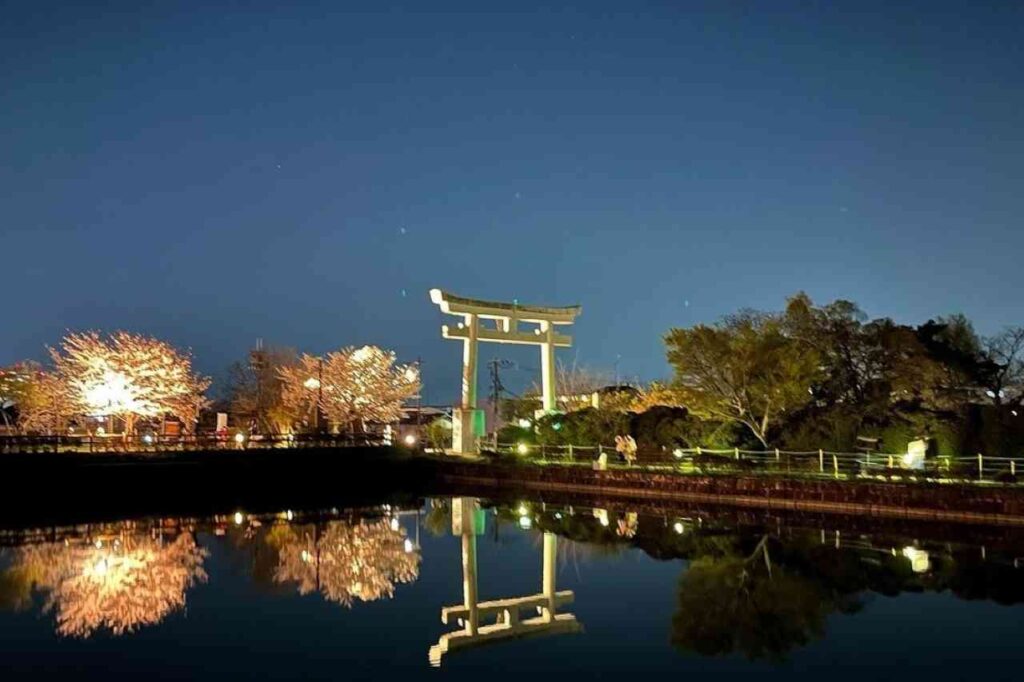

Best time to visit: Late March - early April
Hachijogaike Pond Cherry Blossom Light-up
Period / March 29, 2025 (Sat) - April 6, 2025 (Sun)
*Subject to change depending on the situation.
Hours of visitation: 18:00-21:00
Admission fee/free
The Sagano Trolley Train is a sightseeing train that allows you to enjoy the natural scenery of the Hozugawa River Gorge. The 25-minute train ride in a classic and cute locomotive is full of spectacular scenery that you should not miss. The train conductor will guide you through the valley, and you will be able to see cherry blossoms in the valley that you cannot see in town.
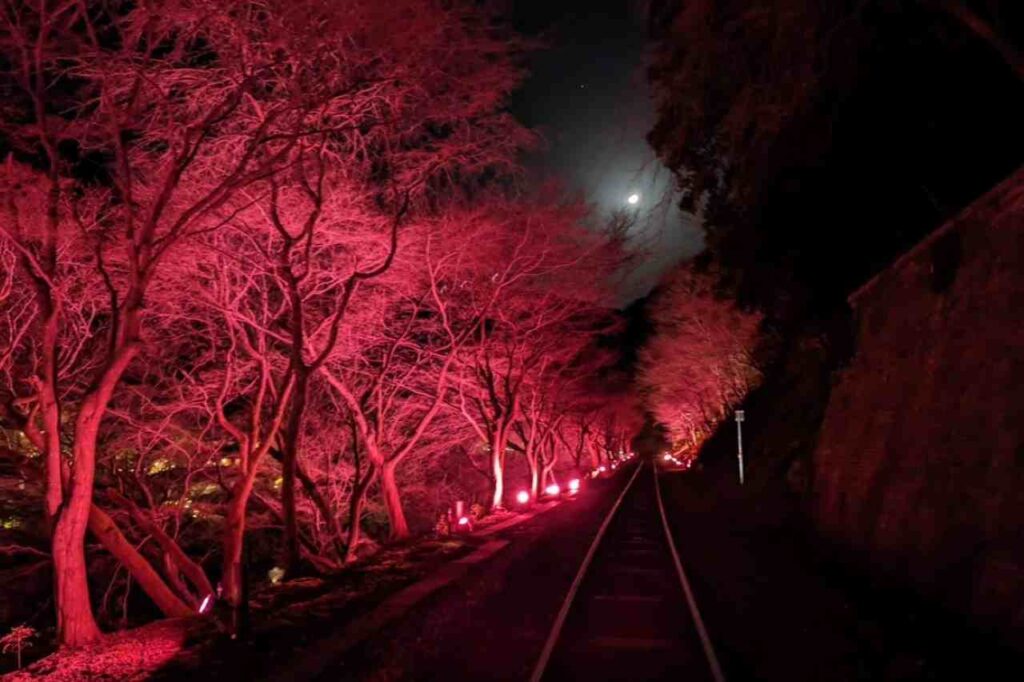

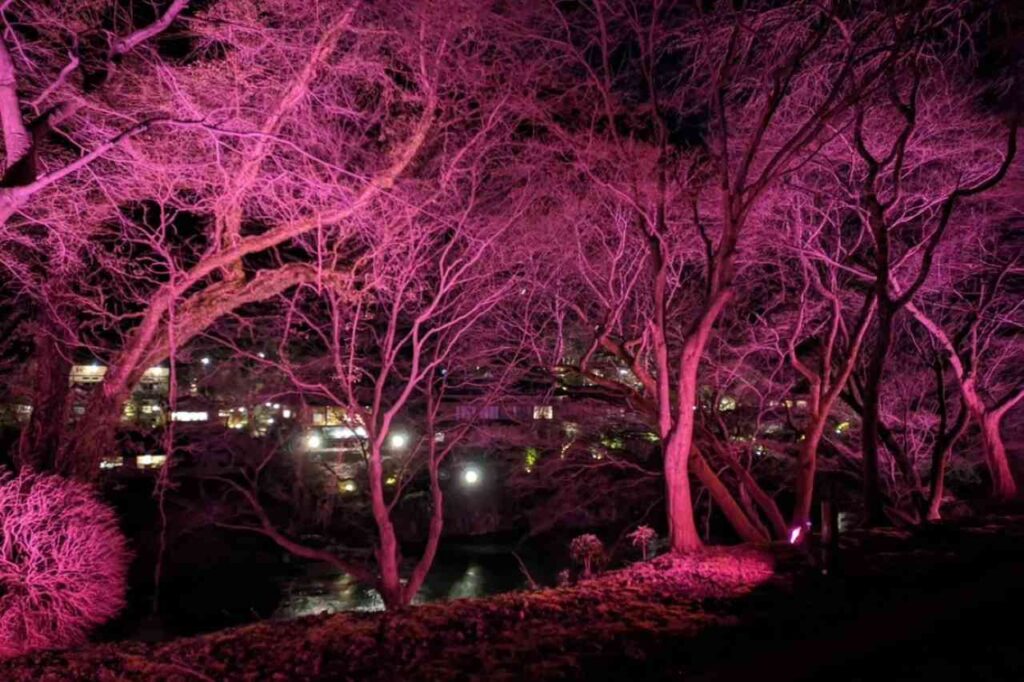

Best time to visit: Mid-March to early April
Spring Lighting & Illumination"
Period / Thursday, March 20, 2025 to Sunday, April 6, 2025
Hours / 16:30 to the last train
*Temporary trains will be operated during the period, with one extra round trip in the evening.
One round-trip service is available on March 28 (Fri.)-30 (Sun.) and April 4 (Fri.)-6 (Sun.).
Fare: Adults 880 yen, children 440 yen
The area along the Shirakawa River that runs from Higashiyama to the Gion area is called "Gion Shirakawa.
In particular, the Gion Shinbashi area near Tatsumi Bridge and Tatsumi Daimeishin Shrine was designated as a national preservation area for traditional buildings in 1976, and more than 50 teahouse-style townhouses are still preserved in this area today. At night, the rows of cherry trees along the Shirakawa River from Kawabata-dori to Tatsumi-bashi Bridge are lit up, creating an even more emotional atmosphere with the traditional buildings and cobblestone pavement.
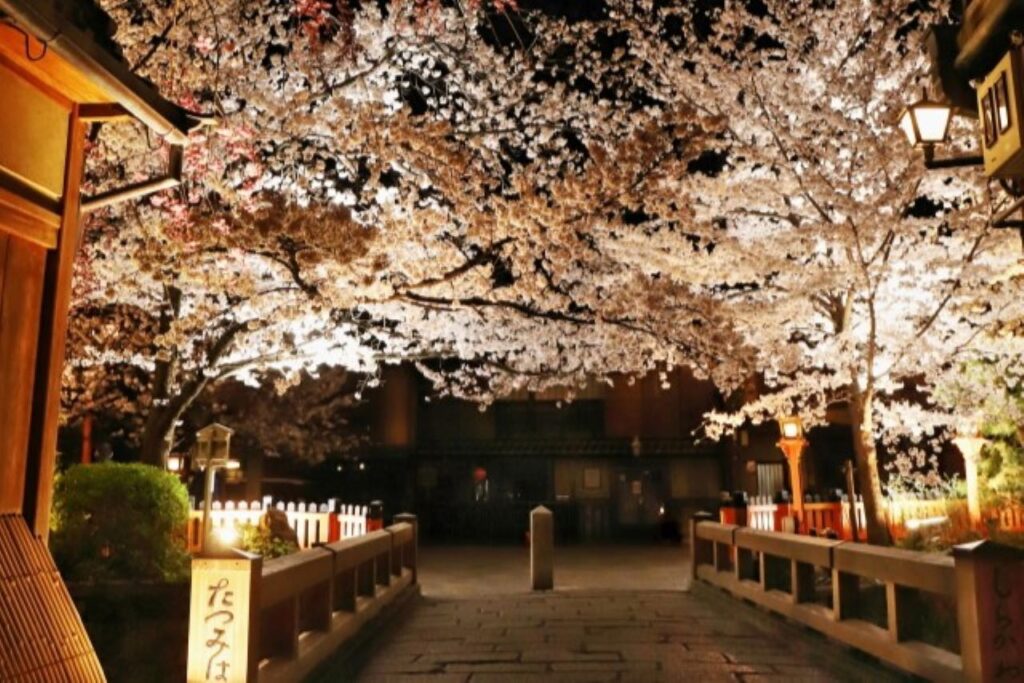

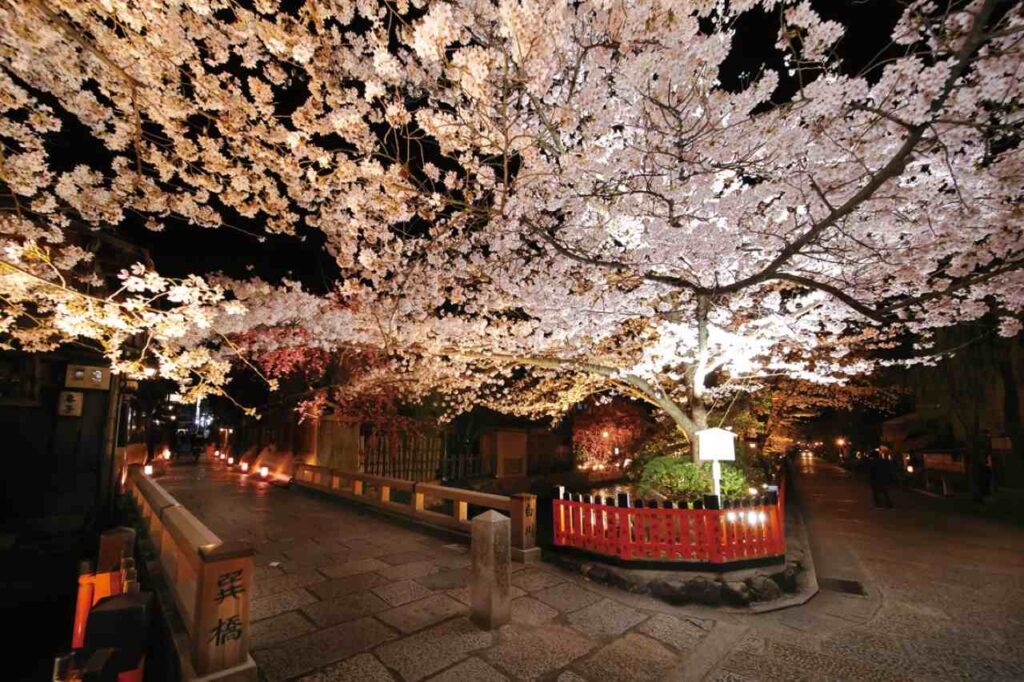

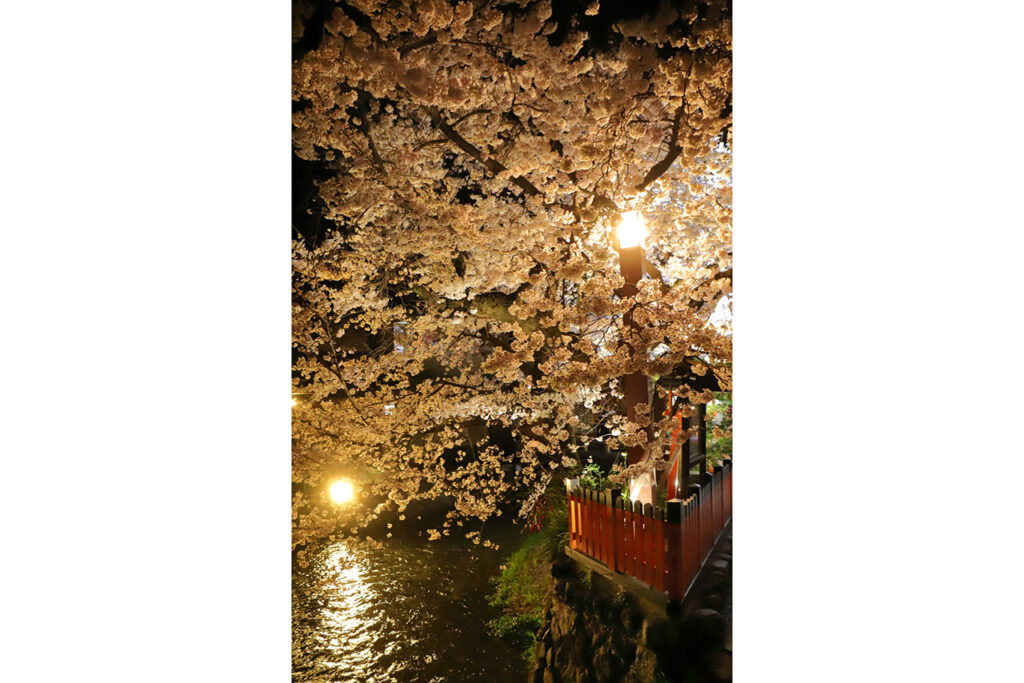

Best time to visit: Late March - early April
The 32nd Gion Shirakawa Yoizakura Light-up
Period / Friday, March 28, 2025 - Sunday, April 6, 2025
Hours/18:00-22:00
free to stroll (i.e. to take a stroll)
Shoju-in Temple was built in Shoji 2 (1200) as the pagoda temple of the Iryo Kyokoji Temple [Shoju-in Temple].
The heart-shaped inome, a traditional Japanese pattern, is meant to ward off misfortune and invite good fortune. The view from inside the Kyakuden is breathtaking, as the inome window is tinted in cherry blossom colors and filled with cherry blossoms as far as the eye can see. The nearly 100-year-old cherry tree on the side of the main hall is also a sight not to be missed.
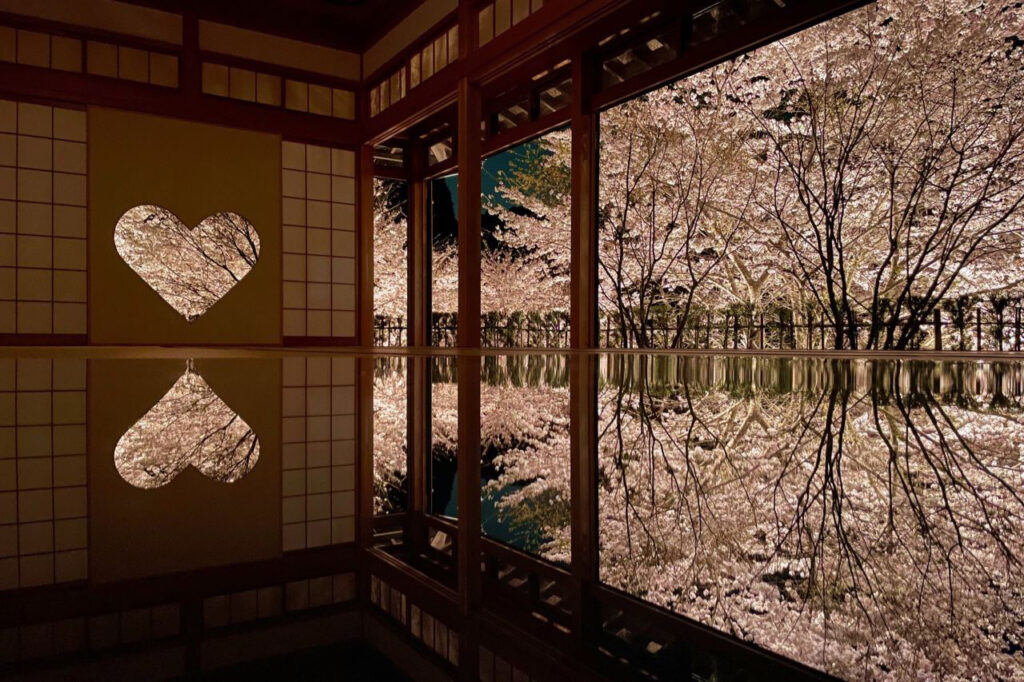

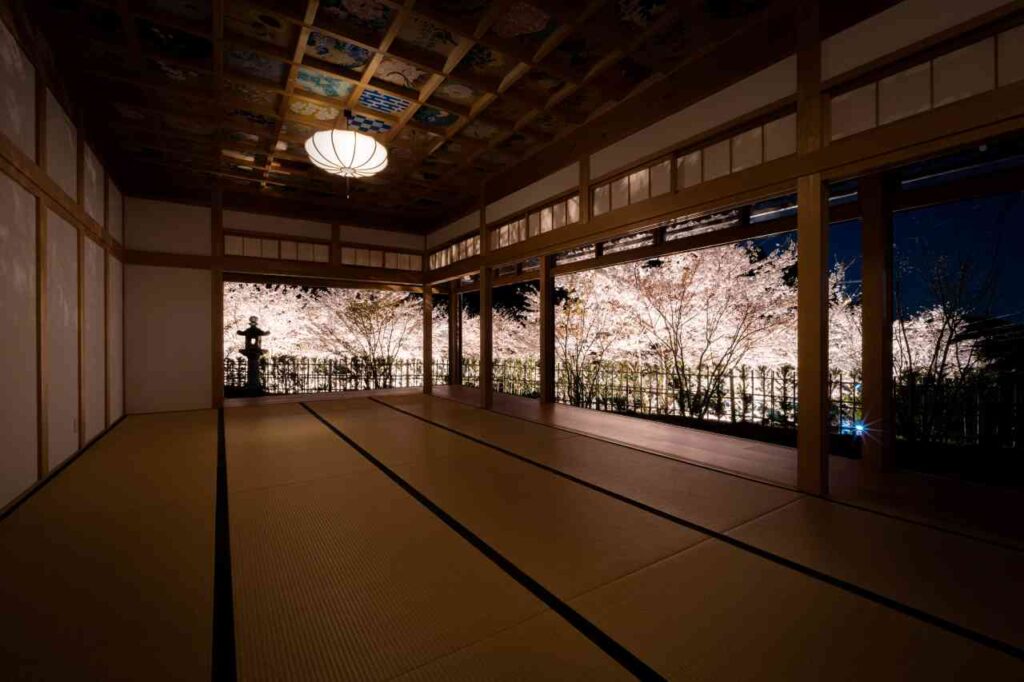

Best time to visit: Late March - early April
2025Spring Special Viewing "Kanzakura-kai (Cherry Blossom Viewing (Cherry Blossom Illumination)
Period / Friday, March 28 - Monday, March 31, 2025 and Friday, April 4 - Sunday, April 6, 2025
*Please note that the period may be extended or additional days may be added depending on the blooming of cherry trees.
Hours: 17:30-19:00 19:30-20:30 *Full changeover system
Entrance fee: Adults 1,000 yen, elementary school students 500 yen
Special viewing is by reservation only.here
Approximately 360 cherry trees, including Someiyoshino cherry trees, are planted from Nijo Dori to Gojo Dori [Kiyamachi Dori]. Of these, the cherry trees in Shimokiyacho, from Shijo Dori to Matsubara Dori, are illuminated during the blooming period. Enjoy the nighttime cherry blossoms of the city floating on the surface of the Takase River.


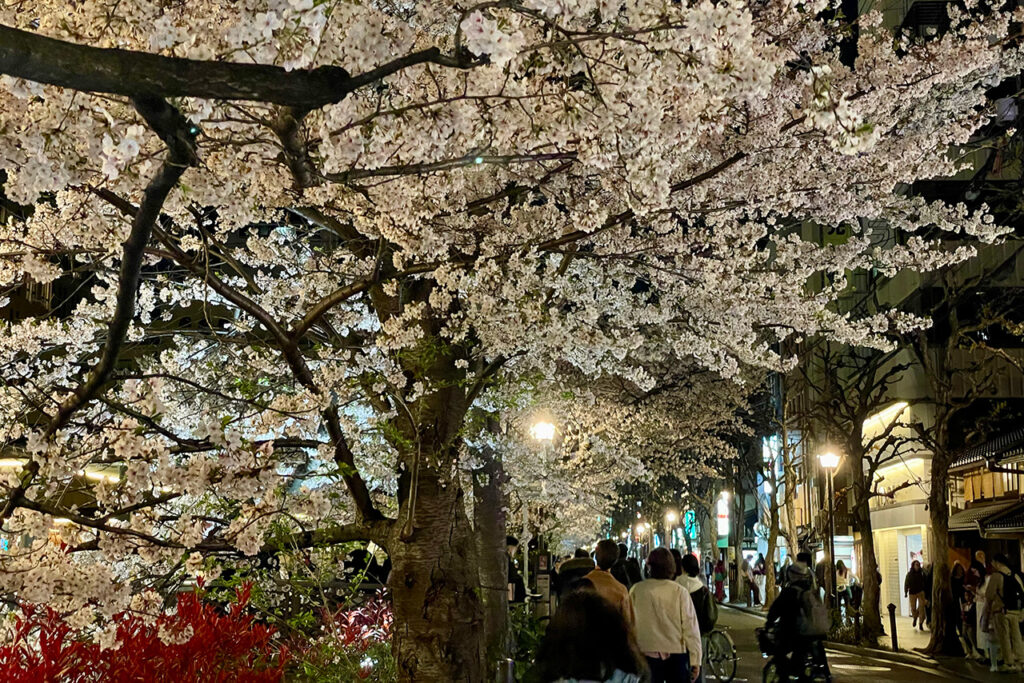

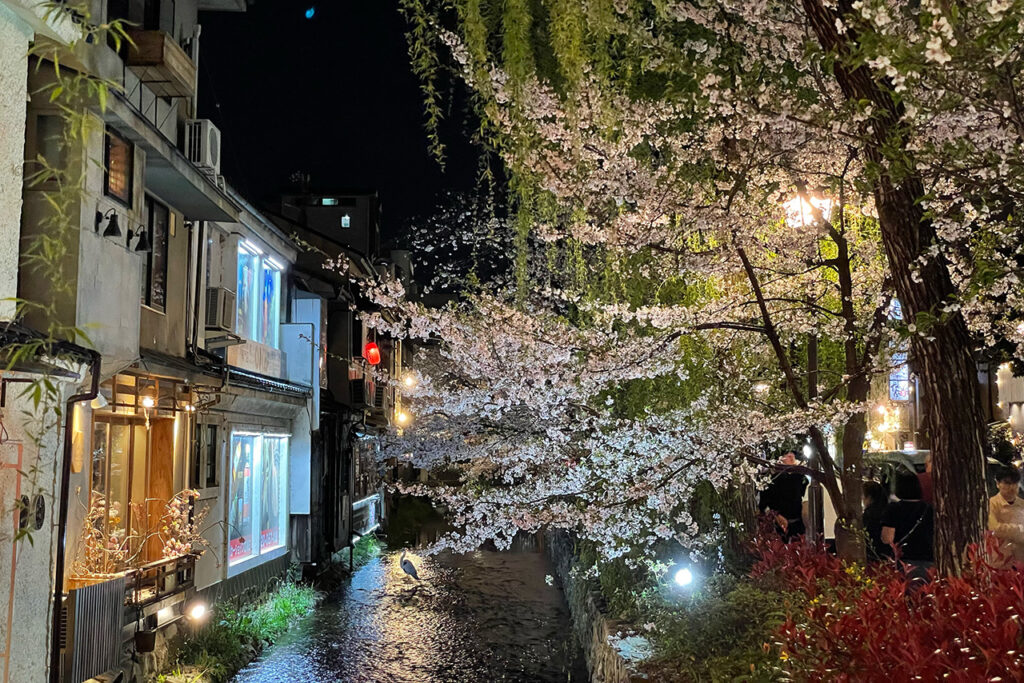

Best time to visit: Late March - early April
free to stroll (i.e. to take a stroll)
Founded by Priest Nichizo in the Kamakura period (1185-1333). Myokenji Temple was granted by Emperor Godaigo to pray for the protection of the nation and the prosperity of the imperial family, and even today it is associated with the imperial family. The garden of Shikai Shoin Garden facing the Imperial Gate is illuminated and visitors can enjoy the Japanese garden with weeping cherry trees in a solemn atmosphere.
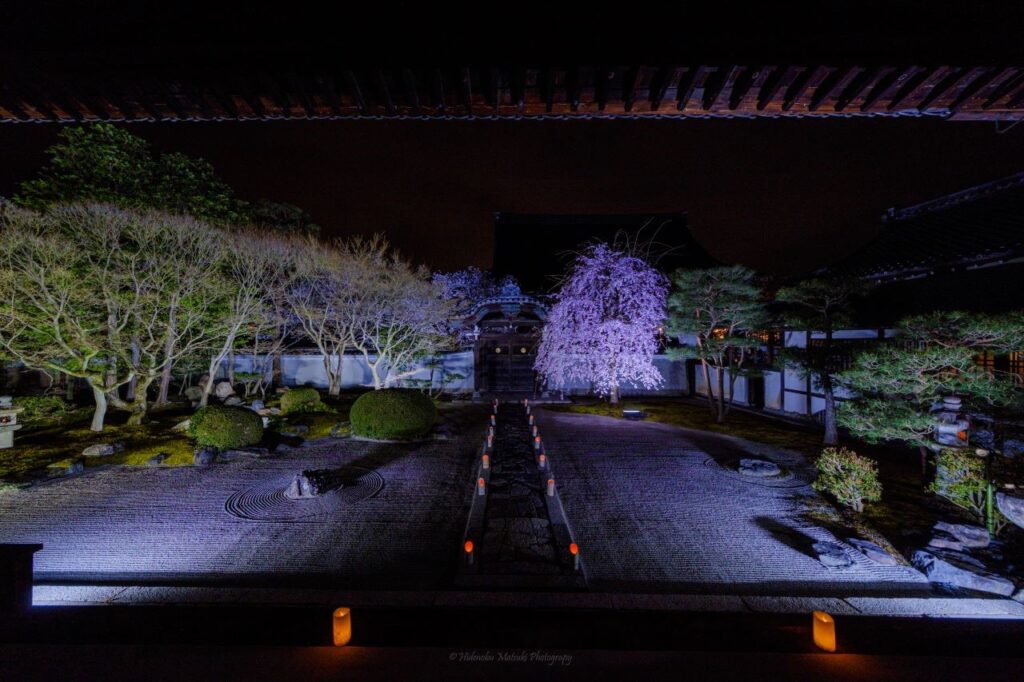

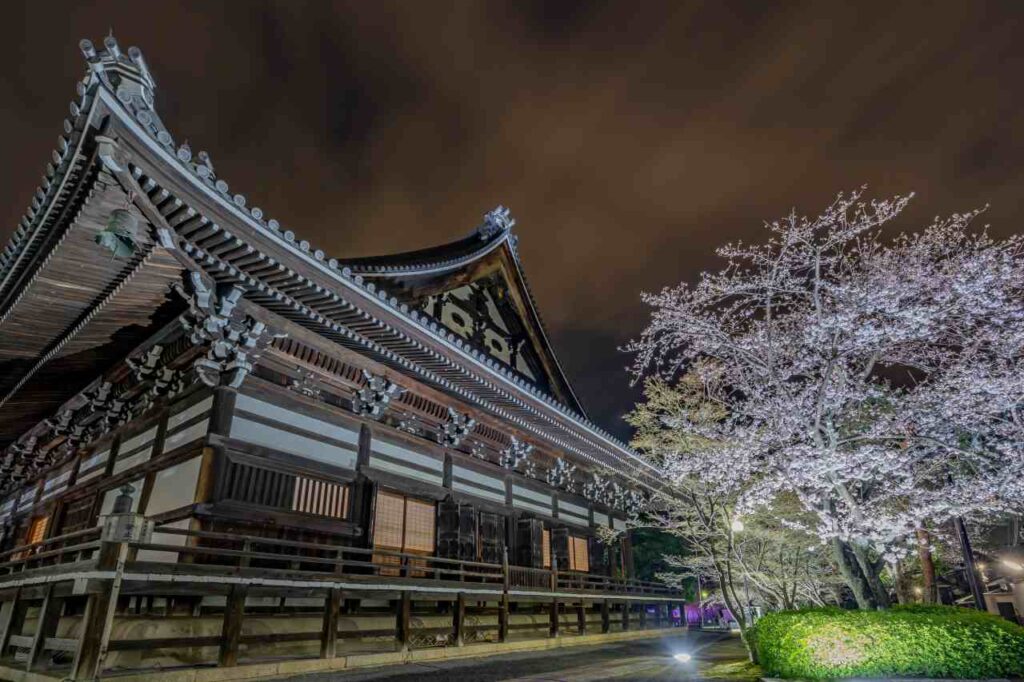

Best time to visit: Late March - early April
Spring Special Open House
Period / March 22 (Saturday) to April 6 (Sunday), 2025
Extension may be possible depending on the blooming of cherry blossoms.
Time/ 10:00 - 16:00 18:00 - 20:00 (reception until 20:00) *Light up is available.
Admission: ¥800 for adults, free for elementary school students and younger
Myoman-ji Temple was founded in 1389 by Nichiji Taisho, a Buddhist priest, in Rokujo Bomon Muromachi.
The temple area was later moved to its present location as time went by. The cherry blossom garden in the corner centering on the Daishoin is famous for its magnificent weeping cherry trees and approximately 3,000 azalea plants. The temple grounds can be enjoyed in all four seasons throughout the year.
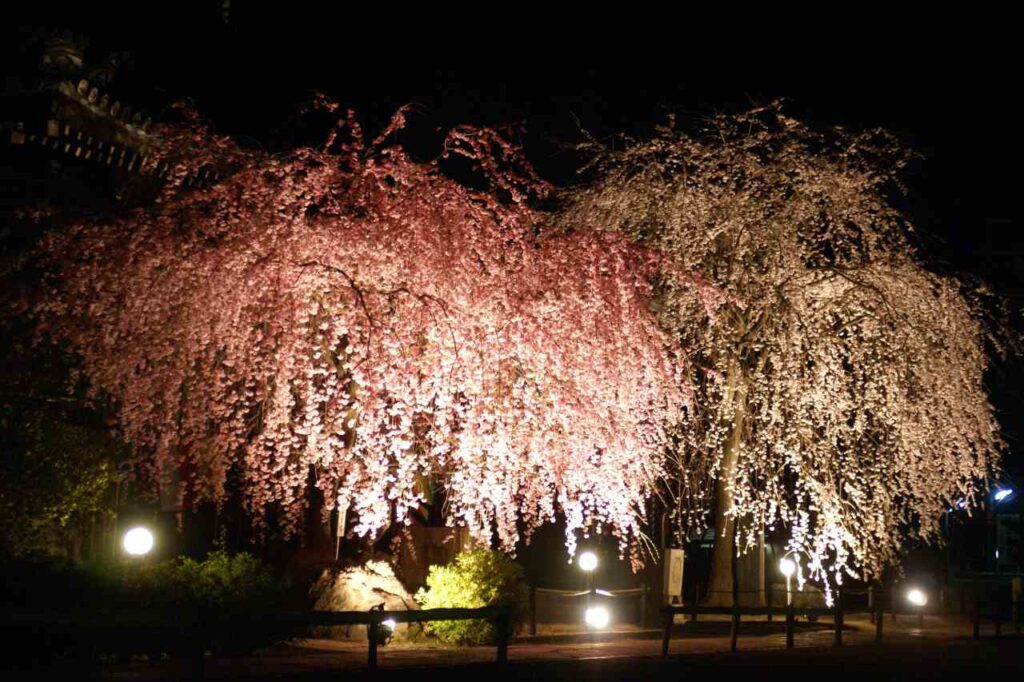

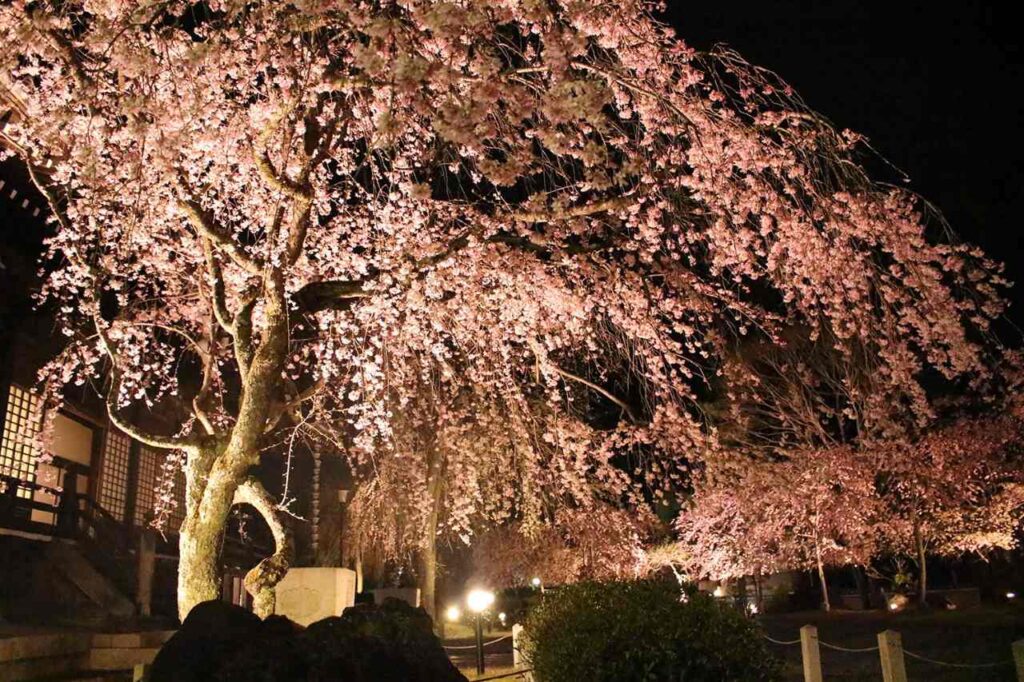

Best time to visit: Late March - early April
Cherry Blossom Garden Light-up Special Viewing" (Japanese only)
Period: March 29 (Sat) - until the cherry blossoms fall
Hours of visitation: 17:00 - 20:00
Admission / Free *Only in the cherry blossom garden
The predecessor of the temple [Sumizome-ji Temple] is said to have been founded by Yoshifusa Fujiwara in the Heian period (794-1185).
The temple is also called "Sakura-dera" (cherry blossom temple), and its name comes from a poem written by Mineo Ueno, a poet of the Heian period (794-1185) in mourning for the death of Mototsune Fujiwara, the chief advisor to the Emperor, which reads, "If I have a cherry blossom in the field in Fukakusa, this year only, it will bloom in sumizome. The temple grounds are illuminated with light-colored sumizome cherry blossoms, someiyoshino cherry trees, yaezakura cherry trees, and other historic cherry trees.
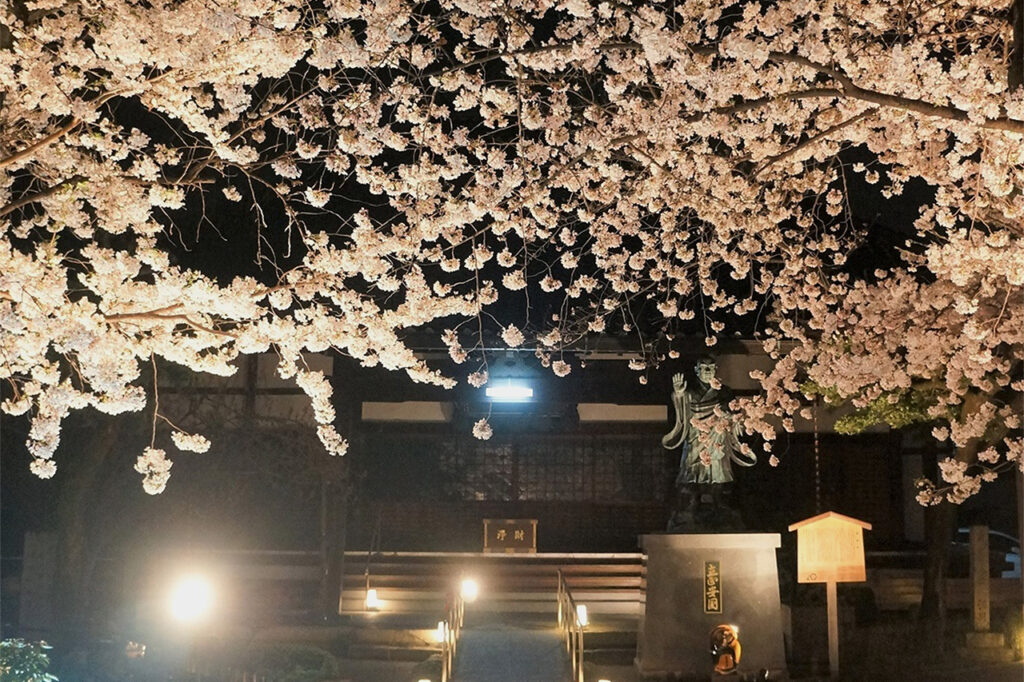

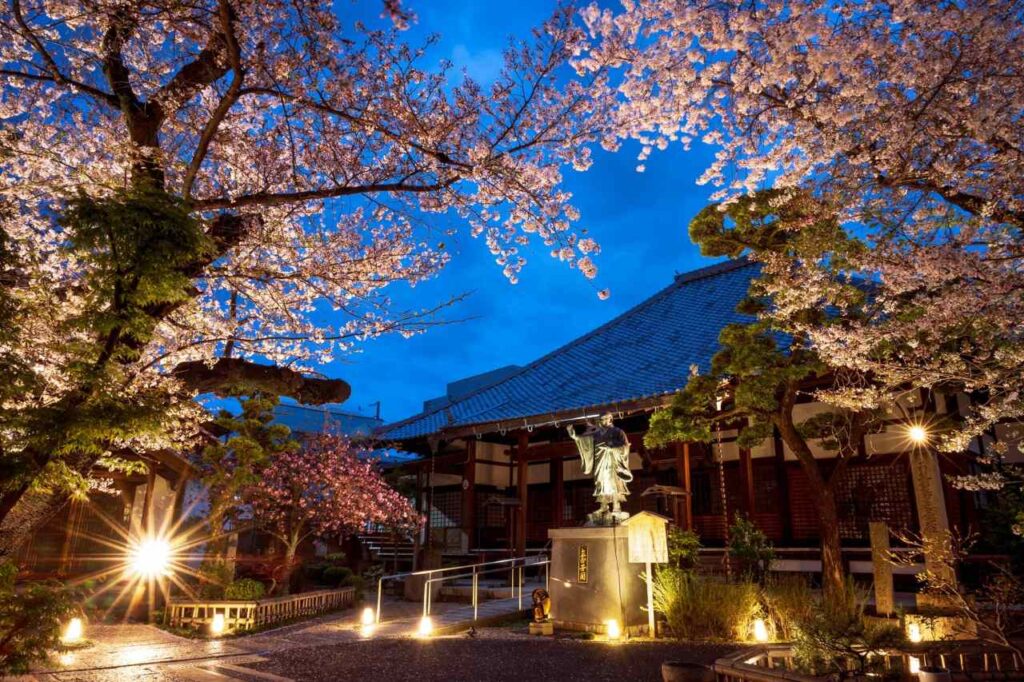

Best time to visit: Late March to mid-April
Cherry blossoms light up at night.
Period / Wednesday, March 26, 2025 - early April
Hours of visitation: 18:00-21:00
Admission fee/free
The Biwako Sosui, a canal built in the Meiji era to channel water from Lake Biwa from Shiga Prefecture to Kyoto City.
During the cherry blossom season, someiyoshino cherry trees and mountain cherry trees planted along both banks of the canal from around Shikaseki Bridge to about 200 meters downstream are lit up, inviting visitors into a fantastic world of cherry blossoms at night. The area leading to the adjacent Mitsui Temple (Sonjoji Temple) is one of the best cherry blossom viewing spots in the Kansai region.
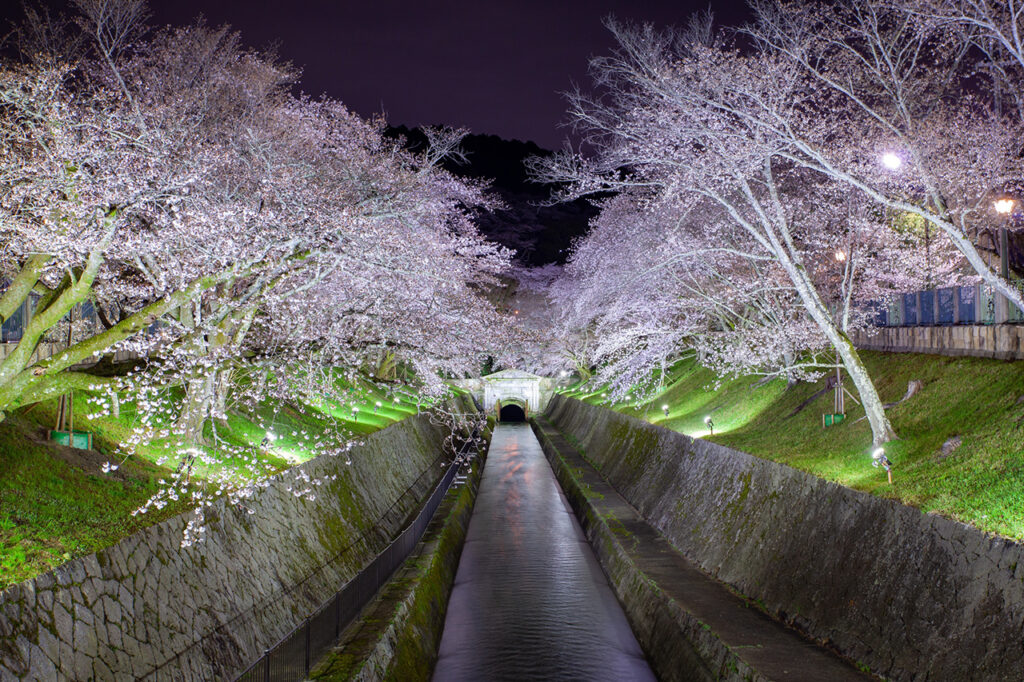

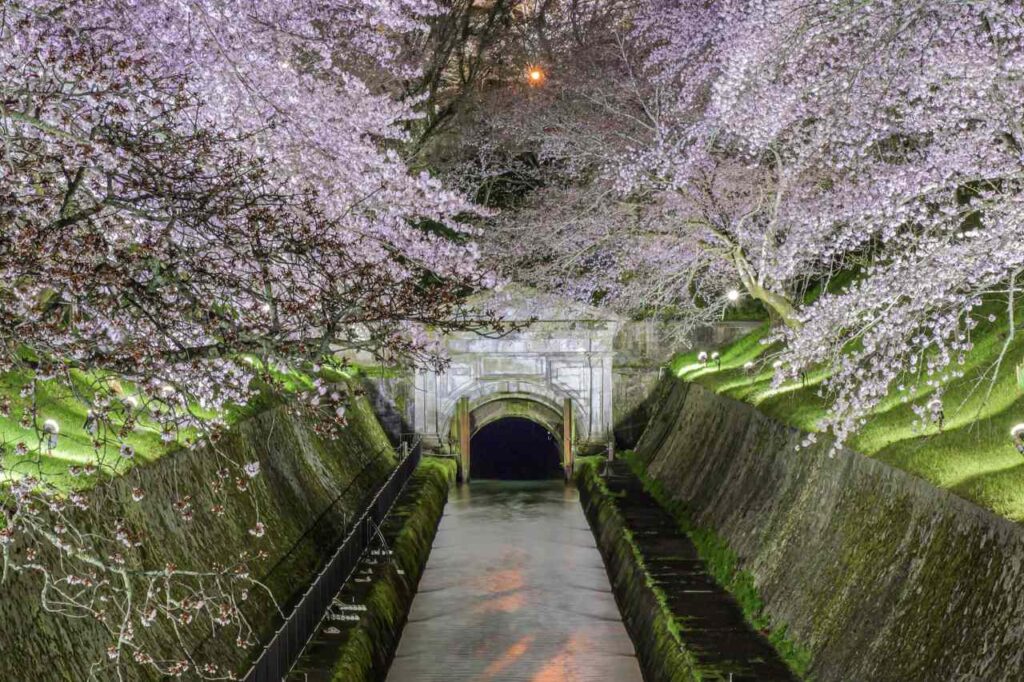

Best time to visit: Early to mid-April
Biwako Otsu Spring Light-up - Cherry Blossoms on Lake Biwa Sosui
Period / Tuesday, March 25, 2025 - Sunday, April 13, 2025
Hours/18:00-21:30
Fee/No charge
Thank you for reading this article. We would love to hear your recommendations for cherry blossom lighting spots!
Loading...
Over 600 interviews per year! An order site carefully selected by the editors who knows Kyoto and Shiga.
nowOfficial LINE friend registration500 yen OFF coupon is being issued!
Distributed every Friday morning at 8:00 am! From new restaurant information to event information that we want to share with you, We deliver articles about Kyoto that are useful to know. About 20,000 people have registered.Click here to add a friend!
 News
News Feature article
Feature article Featured event
Featured event